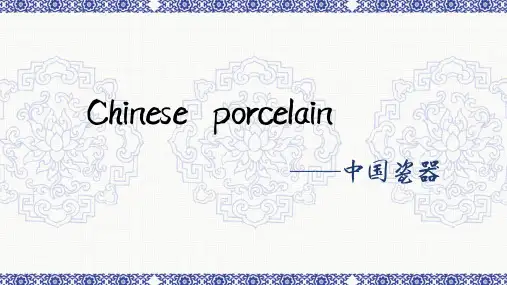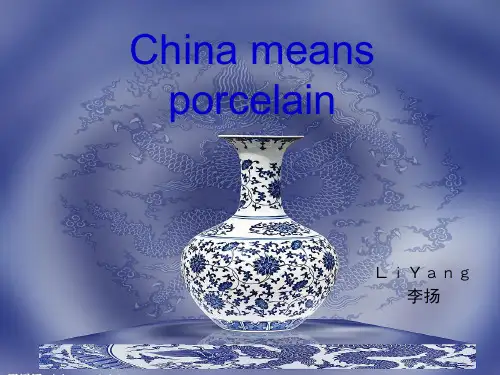瓷器英文PPT
- 格式:ppt
- 大小:4.26 MB
- 文档页数:28

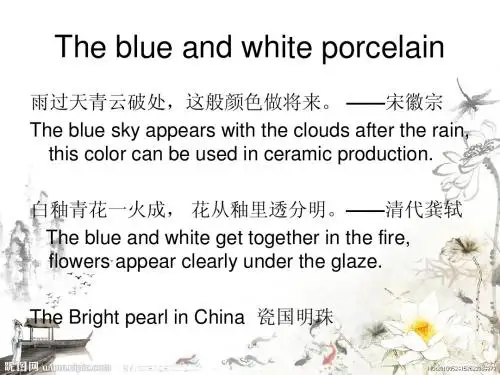
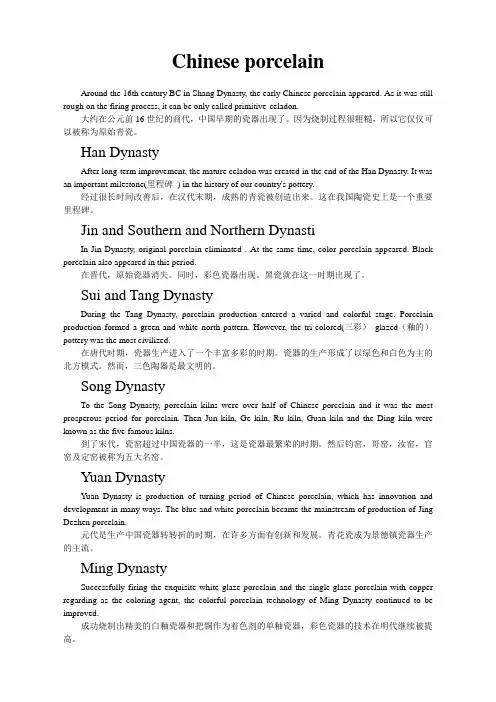
Chinese porcelainAround the 16th century BC in Shang Dynasty, the early Chinese porcelain appeared. As it was still rough on the firing process, it can be only called primitive-celadon.大约在公元前16世纪的商代,中国早期的瓷器出现了。
因为烧制过程很粗糙,所以它仅仅可以被称为原始青瓷。
Han DynastyAfter long-term improvement, the mature celadon was created in the end of the Han Dynasty. It was an important milestone(里程碑) in the history of our country's pottery.经过很长时间改善后,在汉代末期,成熟的青瓷被创造出来。
这在我国陶瓷史上是一个重要里程碑。
Jin and Southern and Northern DynastiIn Jin Dynasty, original porcelain eliminated . At the same time, color porcelain appeared. Black porcelain also appeared in this period.在晋代,原始瓷器消失。
同时,彩色瓷器出现。
黑瓷就在这一时期出现了。
Sui and Tang DynastyDuring the Tang Dynasty, porcelain production entered a varied and colorful stage. Porcelain production formed a green and white north pattern. However, the tri-colored(三彩)glazed(釉的)pottery was the most civilized.在唐代时期,瓷器生产进入了一个丰富多彩的时期。

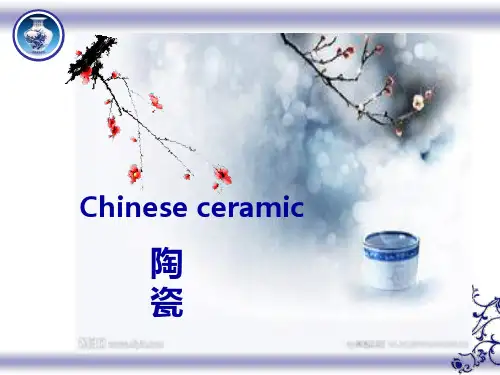
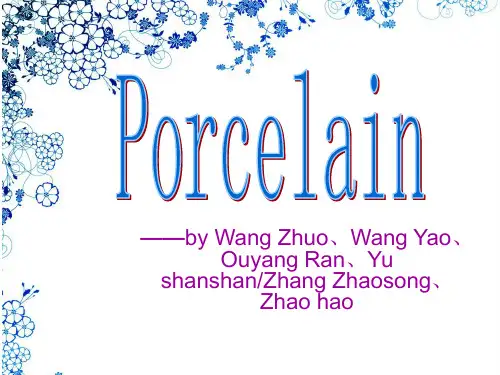
——by Wang Zhuo、Wang Yao、Ouyang Ran、Yu shanshan/Zhang Zhaosong、Zhao haoLet’s Begin Our Trip at Jingde ZhenJingdezhensightseeingJingdezhen. is very famous as “the capital of porcelain" It's China's main porcelain-making center since the Song dynasty, as early as 1712 needed to keep three thousand kilns fired day and night.Three main kinds of porcelain•hard-paste porcelain(硬瓷)•soft-paste porcelain(釉瓷)•bone china(骨瓷)The blue and white porcelain•Blue and whiteporcelain enameltransparent water, tires,white light thin body ofporcelain body apply toblue, elegant decoration,pure and fresh vitality.Once appear blue rage,become the writings ofjingdezhen tradition.Tri-coloured glazed pottery of theTang DynastyThe Histroy of PorcelainNeolithic age(石器时代)In the history of Chinese ceramics, porcelain derived frompottery(陶)and appeared later. In the early years,people have made splendid achievements in ceramic fieldespecially in Yellow River and Changjiang River drainagearea where a lot of potteries and pottery fragments in theNeolithic age were unearthed at historical sites. Some ofthem were not only commodities, but also artworks suchas ancient painted pottery and pottery figurine(塑像).With the development of pottery industry, the previousclay-strip forming technique has been changed to throwclay(粘土)method,while advanced side-fired kiln andshaft kiln replaced ground firing. People at that time alsogot some experience on how to control the temperature.The highest firing temperature had reached 1100℃, whichwas quite close to the firing temperature between potteryand porcelain. In the early period of Yin and ShangDynasty,the appearance of white pottery whose materialDong Han、W ei、Jin In Dong Han Dynasty, the appearance of mature celadon(青瓷)in Yue kiln was a milestone in the history of Chinese ceramics. Wei Dynasty, Jin Dynasty, the South and North Dynasty were just the seedtime. At that time, celadon played an important role in ceramics, which was widely fired. In the mean time, a small quality of black glazed(上釉的)porcelain and white glazed porcelain were discovered. Because of the unity of different nations and the introduction of Buddhism(佛教), the ceramic style became various duringSui and Tang Dyansty In Sui and Tang Dyansty, the Chinese politics, economy, culture and trade became unprecedentedly prosperous, which promoted the progress of ceramics industry, the expansion of ceramic market and later formed the situation of "celadon in south and white porcelain in north."(南青北白) Celadon was the main product of South China. Yue kiln was the typical representative with high artistic value. The tyre(胎)was light, thin and compact; the glaze layer(釉面)was transparent and exquisite. White porcelain of Xing kiln in Tang Dynasty was the representative of "North white". The degree of whiteness in both body and glaze was good. Its body was compact and usually had a ringing sound when being knocked.tri-coloured glazedpottery of the TangDynastySong Dynasty Song Dynasty was the third prosperous period of the feudal society. Technology, culture, art and handicraft were highly developed. The ceramic industry was flourishing too. Porcelain kilns with regional feature spread all over the country, which formed the layout of "six kiln factions(派系)" and "five famous kilns". "Six kiln factions" were Ding kiln faction, Jun kiln faction, Yaozhou kiln faction, Cizhou kiln faction, Longquan kiln faction and Jingdezhen kiln faction. "Five famous kilns" were Guan kiln, Ru kiln, Ge kiln, Ding kiln and Jun kiln. After the establishment of Guan kilns in Song Dynasty, different artistic styles were formed in folk kilns.The famous porcelain city Jingdezhen grew up in Yuan Dynasty, and it was known for its blue-and-white porcelain, underglazed red porcelain and egg white porcelain.Ding kiln Guan kilnMing and Qing Dynasty In Ming and Qing Dynasty, Chinese porcelain art took on a brilliant and splendid look after thousands of years of development. Ancient painted porcelain became prosperous: such as blue-and-white, wu-cai, dou-cai, plain tri-color, underglazed san-cai, enamel color, fen-cai and so on. The painted porcelains in Ming and Qing Dynasty merged the ceramic art into a whole and gradually became perfect. Single color glaze were of various kinds: sacrificial red glaze, sacrificial blue glaze, Lang kiln red glaze, Jiangdou red glaze, yellow glaze, peacock green glaze and so on. Besides, new progress has been made in the making of ceramics. For example, wheel jiggering(用转模车制陶器)has replaced bamboo knife jiggering. Moreover, blowing glaze(吹釉)technology began to be used. From then on, the quality and quantity of porcelain increased rapidly. The ceramic industry of Ming and Qing Dynasty reached theA history of Chinese ceramics(制陶术), is an image of Chinese history, Chinese national culture.Thanks!。


